| Listing 1 - 10 of 19 | << page >> |
Sort by
|
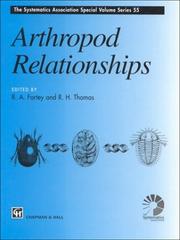
ISBN: 0412754207 9401060576 9401149046 Year: 1997 Volume: 55 Publisher: London Chapman & Hall
Abstract | Keywords | Export | Availability | Bookmark
 Loading...
Loading...Choose an application
- Reference Manager
- EndNote
- RefWorks (Direct export to RefWorks)
The arthropods contain more species than any other animal group, but the evolutionary pathways which led to their current diversity are still an issue of controversy. Arthropod Relationships provides an overview of our current understanding, responding to the new data arising from sequencing DNA, the discovery of new Cambrian fossils as direct evidence of early arthropod history, and developmental genetics. These new areas of research have stimulated a reconsideration of classical morphology and embryology. Arthropod Relationships is the first synthesis of the current debate to emerge: not since the volume edited by Gupta was published in 1979 has the arthropod phylogeny debate been, considered in this depth and breadth. Leaders in the various branches of arthropod biology have contributed to this volume. Chapters focus progressively from the general issues to the specific problems involving particular groups, and thence to a consideration of embryology and genetics. This wide range of disciplines is drawn on to approach an understanding of arthropod relationships, and to provide the most timely account of arthropod phylogeny. This book should be read by evolutionary biologists, palaeontologists, developmental geneticists and invertebrate zoologists. It will have a special interest for post-graduate students working in these fields.
RBINS-REPRINT --- Offprints --- Arthropoda --- Arthropods --- Bilateria --- Invertebrates --- Evolution --- Evolution. --- Evolutionary biology. --- Invertebrates. --- Animal systematics. --- Animal taxonomy. --- Evolutionary Biology. --- Animal Systematics/Taxonomy/Biogeography. --- Animal classification --- Animal systematics --- Animal taxonomy --- Classification --- Systematic zoology --- Systematics (Zoology) --- Taxonomy, Animal --- Zoological classification --- Zoological systematics --- Zoological taxonomy --- Zoology --- Invertebrata --- Animals --- Animal evolution --- Biological evolution --- Darwinism --- Evolutionary biology --- Evolutionary science --- Origin of species --- Biology --- Biological fitness --- Homoplasy --- Natural selection --- Phylogeny --- Life sciences. --- Biosciences --- Sciences, Life --- Science

ISBN: 058534289X 0306456958 Year: 1997 Publisher: New York, NY : Springer,
Abstract | Keywords | Export | Availability | Bookmark
 Loading...
Loading...Choose an application
- Reference Manager
- EndNote
- RefWorks (Direct export to RefWorks)
Rough-and-tumble play provided one of the paradigmatic examples of the application of ethological methods, back in the 1970's. Since then, a modest number of - searchers have developed our knowledge of this kind of activity, using a variety of methods, and addressing some quite fundamental questions about age changes, sex differences, nature and function of behaviour. In this chapter I will review work on this topic, mentioning particularly the interest in comparing results from different informants and different methods of investigation. Briefly, rough-and-tumble play (or R&T for short) refers to a cluster of behaviours whose core is rough but playful wrestling and tumbling on the ground; and whose general characteristic is that the behaviours seem to be agonistic but in a non-serious, playful c- text. The varieties of R&T, and the detailed differences between rough-and-tumble play and real fighting, will be discussed later. 2. A BRIEF HISTORY OF RESEARCH ON R&T In his pioneering work on human play, Groos (1901) described many kinds of rough-and-tumble play. However, R&T was virtually an ignored topic from then until the late 1960's. There was, of course, a flowering of observational research on children in the 1920s and 1930s, especially in North America; but this research had a strong practical o- entation, and lacked the cross-species perspective and evolutionary orientation present in Groos' work.
Human behavior --- Genetic psychology --- Psychobiology --- Behavior evolution --- Evolution (Biology). --- Neurosciences. --- Psychology, clinical. --- Sexual behavior. --- Archaeology. --- Evolutionary Biology. --- Clinical Psychology. --- Sexual Behavior. --- Evolutionary biology. --- Clinical psychology. --- Sexual psychology. --- Archeology --- Anthropology --- Auxiliary sciences of history --- History --- Antiquities --- Psychology, Sexual --- Sex --- Sexual behavior, Psychology of --- Sexual psychology --- Sensuality --- Psychiatry --- Psychology, Applied --- Psychological tests --- Neural sciences --- Neurological sciences --- Neuroscience --- Medical sciences --- Nervous system --- Animal evolution --- Animals --- Biological evolution --- Darwinism --- Evolutionary biology --- Evolutionary science --- Origin of species --- Biology --- Evolution --- Biological fitness --- Homoplasy --- Natural selection --- Phylogeny --- Psychological aspects
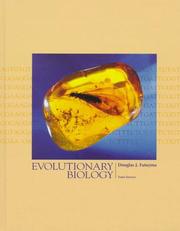
ISBN: 0878931899 9780878931897 Year: 1997 Publisher: Sunderland Sinauer Associates
Abstract | Keywords | Export | Availability | Bookmark
 Loading...
Loading...Choose an application
- Reference Manager
- EndNote
- RefWorks (Direct export to RefWorks)
575.8 --- Evolution (Biology) --- #WDIR:wbse --- Animal evolution --- Animals --- Biological evolution --- Darwinism --- Evolutionary biology --- Evolutionary science --- Origin of species --- Biology --- Evolution --- Biological fitness --- Homoplasy --- Natural selection --- Phylogeny --- Evolution. Origin of species. Phylogeny --- 575.8 Evolution. Origin of species. Phylogeny --- Selection naturelle --- GBZ General Biology, Zoology & Biophilosophy --- biodiversity --- evolutionary biology --- macroevolution --- paleontology --- Evolution (Biology). --- Evolution. Phylogeny --- biology --- Évolution --- evolution --- Biodiversity --- evolution. --- Acqui 2006
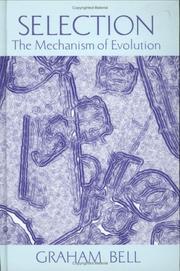
ISBN: 041205521X 0412055317 146155991X 1461377390 1461559774 Year: 1997 Publisher: New York Chapman and Hall
Abstract | Keywords | Export | Availability | Bookmark
 Loading...
Loading...Choose an application
- Reference Manager
- EndNote
- RefWorks (Direct export to RefWorks)
This book describes the process of selection and explains how the nature of the process determines the nature of evolutionary change. Written in an uncluttered style, this book will be the first point of reference for anyone looking for a more extensive and authoritative treatment of selection than can be found in any other book.
Evolution. Phylogeny --- Evolution (Biology) --- Natural selection --- Evolution (Biologie) --- Sélection naturelle --- 575.85 --- 575.17 --- Mechanics of evolution. Evolution according to levels of biological systems --- Population genetics. Genetic processes in populations --- Natural selection. --- Evolution (Biology). --- 575.17 Population genetics. Genetic processes in populations --- 575.85 Mechanics of evolution. Evolution according to levels of biological systems --- 575.827.2 --- #WSCH:AAS2 --- Darwinism --- Selection, Natural --- Genetics --- Variation (Biology) --- Biological invasions --- Heredity --- Animal evolution --- Animals --- Biological evolution --- Evolutionary biology --- Evolutionary science --- Origin of species --- Biology --- Evolution --- Biological fitness --- Homoplasy --- Phylogeny --- 575.827.2 Natural selection --- Sélection naturelle --- Evolutionary biology. --- Human genetics. --- Evolutionary Biology. --- Human Genetics. --- Heredity, Human --- Human biology --- Physical anthropology
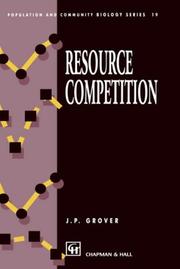
ISBN: 0412749300 1461379393 1461563976 9780412749308 Year: 1997 Volume: 19 Publisher: London Chapman and Hall
Abstract | Keywords | Export | Availability | Bookmark
 Loading...
Loading...Choose an application
- Reference Manager
- EndNote
- RefWorks (Direct export to RefWorks)
As one of the most quantitative of ecological subdisciplines, resource competition is an important, central area of ecology. Recently research into this area has increased dramatically and resource competition models have become more complex. The characterisation of this phenomenon is therefore the aim of this book. Resource Competition seeks to identify the unifying principles emerging from experimental and theoretical approaches as well as the differences between organisms, illustrating that greater knowledge of resource competition will benefit human and environmental welfare. This book will serve as an indispensable guide to ecologists, evolutionary biologists and environmental managers, and all those interested in resource competition as an emerging discipline.
Competition (Biology) --- 574.3 --- 574.2 --- 574 --- Biotic competition --- Ecological competition --- Interspecific competition --- Intraspecific competition --- Species competition --- Struggle for survival (Biology) --- Survival, Struggle for (Biology) --- Population biology --- Species --- Populations and environment. Population dynamics --- Organisms and environment. Habitat. Preferendum --- General ecology. Biocoenology. Hydrobiology. Biogeography --- 574 General ecology. Biocoenology. Hydrobiology. Biogeography --- 574.2 Organisms and environment. Habitat. Preferendum --- 574.3 Populations and environment. Population dynamics --- Evolutionary biology. --- Ecology . --- Zoology. --- Evolutionary Biology. --- Ecology. --- Biology --- Natural history --- Animals --- Balance of nature --- Bionomics --- Ecological processes --- Ecological science --- Ecological sciences --- Environment --- Environmental biology --- Oecology --- Environmental sciences --- Animal evolution --- Biological evolution --- Darwinism --- Evolutionary biology --- Evolutionary science --- Origin of species --- Evolution --- Biological fitness --- Homoplasy --- Natural selection --- Phylogeny --- Ecology
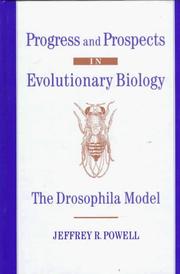
ISBN: 1280442557 019536032X 9786610442553 1601298943 9780195360325 9781280442551 9780195076912 0195076915 0195076915 9781601298942 0197701884 Year: 1997 Publisher: New York : Oxford University Press,
Abstract | Keywords | Export | Availability | Bookmark
 Loading...
Loading...Choose an application
- Reference Manager
- EndNote
- RefWorks (Direct export to RefWorks)
An addition to the OXFORD SERIES IN ECOLOGY AND EVOLUTION for all interested in evolutionary biology spanning the range of evolutionary studies: population genetics, ecology, ecological genetics, speciation, phylogenetics, genome evolution, molecular evolution and development. Empirical results are emphasised and put into context.
Drosophila --- Evolution (Biology) --- Biological models. --- Models, Biological --- Animal evolution --- Animals --- Biological evolution --- Darwinism --- Evolutionary biology --- Evolutionary science --- Origin of species --- Biology --- Evolution --- Biological fitness --- Homoplasy --- Natural selection --- Phylogeny --- Drosophilidae --- Fruit-flies --- Evolution.
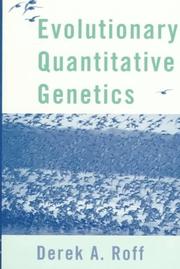
ISBN: 041212971X 1461540801 Year: 1997 Publisher: New York (N.Y.): Chapman and Hall
Abstract | Keywords | Export | Availability | Bookmark
 Loading...
Loading...Choose an application
- Reference Manager
- EndNote
- RefWorks (Direct export to RefWorks)
The impetus for this book arose out of my previous book, The Evolution of Life Histories (Roff, 1992). In that book I presented a single chapter on quanti tative genetic theory. However, as the book was concerned with the evolution of life histories and traits connected to this, the presence of quantitative genetic variation was an underlying theme throughout. Much of the focus was placed on optimality theory, for it is this approach that has proven to be extremely successful in the analysis of life history variation. But quantitative genetics cannot be ig nored, because there are some questions for which optimality approaches are inappropriate; for example, although optimality modeling can address the ques tion of the maintenance of phenotypic variation, it cannot say anything about genetic variation, on which further evolution clearly depends. The present book is, thus, a natural extension of the first. I have approached the problem not from the point of view of an animal or plant breeder but from that of one interested in understanding the evolution of quantitative traits in wild populations. The subject is large with a considerable body of theory: I generally present the assumptions underlying the analysis and the results, giving the relevant references for those interested in the intervening mathematics. My interest is in what quantitative genetics tells me about evolutionary processes; therefore, I have concentrated on areas of research most relevant to field studies.
576.5 --- 575.16 --- 631.523 --- 575.822 --- Evolutionary genetics --- Quantitative genetics --- 575.1 --- Quantitative inheritance --- Genetics --- Genetic evolution --- Evolution (Biology) --- Cell interactions. Intercellular junctions. Cell populations. Cell behaviour in culture --- Developmental genetics. Genetic basis of ontogenesis --- Applied genetics --- Heredity and variation --- Heredity. Inheritance --- Evolutionary genetics. --- Quantitative genetics. --- Biological Processes --- Genetic Processes --- Genetic Phenomena --- Phenomena and Processes --- Biology --- Biological Phenomena --- Biological Science Disciplines --- Natural Science Disciplines --- Disciplines and Occupations --- Biological Evolution --- Genetic Variation --- Genetics, Population --- Health & Biological Sciences --- 575.1 Heredity. Inheritance --- 575.822 Heredity and variation --- 631.523 Applied genetics --- 575.16 Developmental genetics. Genetic basis of ontogenesis --- 576.5 Cell interactions. Intercellular junctions. Cell populations. Cell behaviour in culture --- Evolutionary biology. --- Human genetics. --- Evolutionary Biology. --- Human Genetics. --- Heredity, Human --- Human biology --- Physical anthropology --- Animal evolution --- Animals --- Biological evolution --- Darwinism --- Evolutionary biology --- Evolutionary science --- Origin of species --- Evolution --- Biological fitness --- Homoplasy --- Natural selection --- Phylogeny
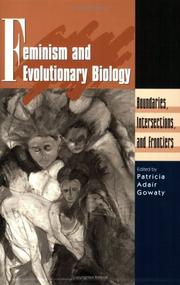
ISBN: 041207351X 0412073617 1461559855 Year: 1997 Publisher: New York London Chapman & Hall
Abstract | Keywords | Export | Availability | Bookmark
 Loading...
Loading...Choose an application
- Reference Manager
- EndNote
- RefWorks (Direct export to RefWorks)
Standing at the intersection of evolutionary biology and feminist theory is a large audience interested in the questions one field raises for the other. Have evolutionary biologists worked largely or strictly within a masculine paradigm, seeing males as evolving and females as merely reacting passively or carried along with the tide? Would our view of nature `red in tooth in claw' be different if women had played a larger role in the creation of evolutionary theory and through education in its transmission to younger generations? Is there any such thing as a feminist science or feminist methodology? For feminists, does any kind of biological determinism undermine their contention that gender roles purely constructed, not inherent in the human species? Does the study of animals have anything to say to those preoccupied with the evolution and behavior of humans? All these questions and many more are addressed by this book, whose contributing authors include leading scholars in both feminism and evolutionary biology. Bound to be controversial, this book is addressed to evolutionary biologists and to feminists and to the large number of people interested in women's studies.
Feminism. --- Feminist theory. --- Human biology. --- Human evolution. --- Sociobiology. --- Anthropobiologie --- Anthropologie biologique --- Biologie [Anthropo] --- Biologie [Menselijke ] --- Biologie [Socio] --- Biologie humaine --- Evolutie [Menselijke ] --- Evolution humaine --- Feminism --- Feminism--Philosophy --- Feminisme --- Feminist sociology --- Feminist theory --- Feministische theorie --- Féminisme --- Homme--Evolution --- Human biology --- Human evolution --- Mens--Evolutie --- Menselijke biologie --- Menselijke evolutie --- Sociobiologie --- Sociobiology --- Theory of feminism --- Théorie féministe --- Women's lib --- Women's liberation movement --- Women's movement --- Evolutionary biology. --- Evolutionary Biology. --- Animal evolution --- Animals --- Biological evolution --- Darwinism --- Evolutionary biology --- Evolutionary science --- Origin of species --- Biology --- Evolution --- Biological fitness --- Homoplasy --- Natural selection --- Phylogeny --- Feminist philosophy --- Biologism --- Psychology, Comparative --- Social evolution --- Physical anthropology --- Evolution (Biology) --- Evolutionary psychology --- Human beings --- Emancipation of women --- Feminist movement --- Women --- Women's liberation --- Social movements --- Anti-feminism --- Philosophy --- Social aspects --- Origin --- Emancipation
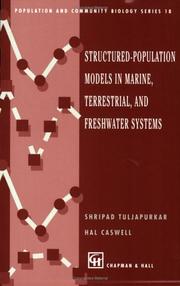
ISBN: 0412072718 1461559731 Year: 1997 Publisher: New York (N.Y.): Chapman and Hall
Abstract | Keywords | Export | Availability | Bookmark
 Loading...
Loading...Choose an application
- Reference Manager
- EndNote
- RefWorks (Direct export to RefWorks)
In the summer of 1993, twenty-six graduate and postdoctoral stu dents and fourteen lecturers converged on Cornell University for a summer school devoted to structured-population models. This school was one of a series to address concepts cutting across the traditional boundaries separating terrestrial, marine, and freshwa ter ecology. Earlier schools resulted in the books Patch Dynamics (S. A. Levin, T. M. Powell & J. H. Steele, eds., Springer-Verlag, Berlin, 1993) and Ecological Time Series (T. M. Powell & J. H. Steele, eds., Chapman and Hall, New York, 1995); a book on food webs is in preparation. Models of population structure (differences among individuals due to age, size, developmental stage, spatial location, or genotype) have an important place in studies of all three kinds of ecosystem. In choosing the participants and lecturers for the school, we se lected for diversity-biologists who knew some mathematics and mathematicians who knew some biology, field biologists sobered by encounters with messy data and theoreticians intoxicated by the elegance of the underlying mathematics, people concerned with long-term evolutionary problems and people concerned with the acute crises of conservation biology. For four weeks, these perspec tives swirled in discussions that started in the lecture hall and carried on into the sweltering Ithaca night. Diversity mayor may not increase stability, but it surely makes things interesting.
Models --- Aquatic communities --- Animal population --- plant population --- population dynamics --- population structure --- Biological competition --- Population distribution --- Daphnia --- Tribolium --- Applied Ecology. --- Mathematical and Computational Biology. --- Biomathematics. Biometry. Biostatistics --- General ecology and biosociology --- Population biology --- 574.3 --- 574.5 --- 591.526 --- 591.526 Population density of an animal species. Reproduction rate. Birth rate. Destruction rate. Death rate --- Population density of an animal species. Reproduction rate. Birth rate. Destruction rate. Death rate --- 574.3 Populations and environment. Population dynamics --- Populations and environment. Population dynamics --- 574.5 Hydrobiology. Aquatic biocoenoses and ecosystems. Food chains --- Hydrobiology. Aquatic biocoenoses and ecosystems. Food chains --- Mathematical models --- Applied ecology. --- Ecology . --- Evolutionary biology. --- Biomathematics. --- Ecology. --- Evolutionary Biology. --- Biology --- Mathematics --- Animal evolution --- Animals --- Biological evolution --- Darwinism --- Evolutionary biology --- Evolutionary science --- Origin of species --- Evolution --- Biological fitness --- Homoplasy --- Natural selection --- Phylogeny --- Balance of nature --- Bionomics --- Ecological processes --- Ecological science --- Ecological sciences --- Environment --- Environmental biology --- Oecology --- Environmental sciences --- Ecology --- Environmental protection --- Nature conservation --- Calathea ovandensis
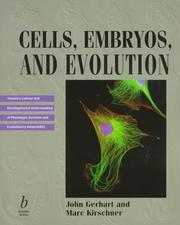
ISBN: 0865425744 9780865425743 Year: 1997 Publisher: Malden, Mass. Blackwell Science
Abstract | Keywords | Export | Availability | Bookmark
 Loading...
Loading...Choose an application
- Reference Manager
- EndNote
- RefWorks (Direct export to RefWorks)
Evolution. Phylogeny --- Histology. Cytology --- General embryology. Developmental biology --- Biological Evolution --- Developmental Biology --- Phenotype --- Cell Biology --- Evolution (Biology) --- Cytology --- Developmental biology --- Cytology. --- Developmental biology. --- Phenotype. --- Evolution (Biology). --- Development (Biology) --- Biology --- Growth --- Ontogeny --- Cell biology --- Cellular biology --- Cells --- Phenotypes --- Genetics --- Genotype-environment interaction --- Animal evolution --- Animals --- Biological evolution --- Darwinism --- Evolutionary biology --- Evolutionary science --- Origin of species --- Evolution --- Biological fitness --- Homoplasy --- Natural selection --- Phylogeny
| Listing 1 - 10 of 19 | << page >> |
Sort by
|

 Search
Search Feedback
Feedback About UniCat
About UniCat  Help
Help News
News